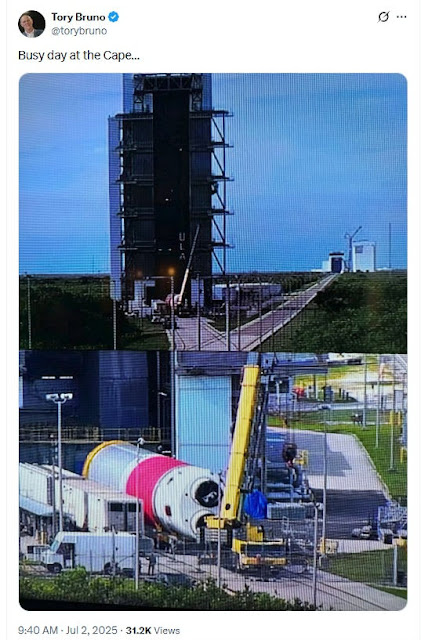On Thursday July 3 Spaceflight Now reported that United Launch Alliance began the stacking process for their first Vulcan for a National Security mission, since the approval was recently granted. ULA refers to this as Launch Vehicle on Stand or LVOS, and it's actually not the first time this third Vulcan was brought to SLC-41, ULA's launch complex on Cape Canaveral Space Force Station.
It was previously readied in late October in support of the USSF-106 mission, the planned, first national security flight of a Vulcan rocket.
However, plans changed as the process of certifying Vulcan to fly these government payloads took longer than expected.
ULA President and CEO Tory Bruno announced the move Wednesday morning, July 2nd, on social media.
During the second of two certification flights for Vulcan, an issue with an insulator component on one of the Northrop Grumman-built GEM 63XL solid rocket motors caused a burn through less than a minute into the early October launch. The rocket was able to compensate for the anomaly, but it resulted in several more months of investigative work before the U.S. Space Force was able to close out its certification work.
In February, faced with delays from the Space Force certifying this vehicle, they pivoted to June 23rd's launch of ULA's Atlas V carrying Amazon's next 27 Kuiper satellites.
“We stay integrated with the spacecraft teams and we were monitoring where [Amazon’s Project] Kuiper was and where the SF-106 partner was and so we made the decision that we had a little time there,” said Gary Wentz, the vice president of Government and Commercial Programs, during an interview with Spaceflight Now in early February.
“We knew we had some out-of-position work that we needed to do on the SF-106 booster. We had to replace some components and then subsequently we would retest those,” Wentz said. “And so, we elected to go ahead and LVOS that booster to get that work off the critical path so that we’re prepared to launch, whether it was 106 or Kuiper.”
Bruno had said the next two launches will be Vulcan NSSL Phase 2 missions: USSF-106 and USSF-87. After those, they're planning is based on around two launches per month for the rest of the year, and at least tentatively alternating between Atlas V and Vulcan.
Unlike most National Security launches, there's actually some word about at least one thing that will be flying on USSF-106: a test of some concepts for a successor to the current GPS navigation satellites.
The USSF-106 mission will carry multiple payloads, but to date, the only one that has been publicly identified is the Department of the Air Force’s Navigation Technology Satellite-3 (NTS-3). The prime contractor is L3Harris Technologies, which integrated an agile positioning, navigation and timing (PNT) payload onto an ESPAStar satellite bus from Northrop Grumman.
The mission is designed and coordinated by the Air Force Research Laboratory (AFRL). It follows in the footsteps of the Navy Research Laboratory’s NTS-1 and NTS-2 satellites that were precursors to the Global Positioning System (GPS) constellation that began deploying in the 1970s.
Spaceflight Now dedicates at least a page the size of one my screens to discussing this NTS-3 payload (along with a photo of an interesting 1/3 scale model of it). Considering the length I'd have to add and a guess at the amount of readers who would find it worth reading, I decided not to include it here, but just leave a link to the source article.

Ah, yeah, sure. We'll see.
ReplyDeleteI think there's a better chance of a successful Starship launch and recovery before BO gets to orbit again.
I am hoping Blue Origin, ULA and SpaceX all get their acts together. Maybe I should just play the lottery?
ReplyDeleteProbably a safer bet than that trifecta.
Delete